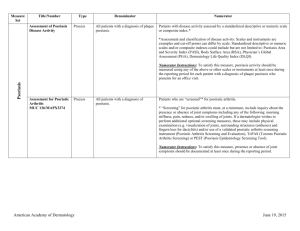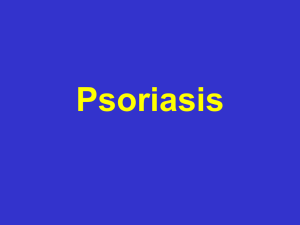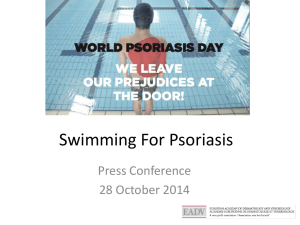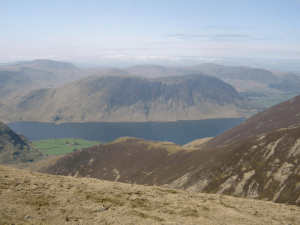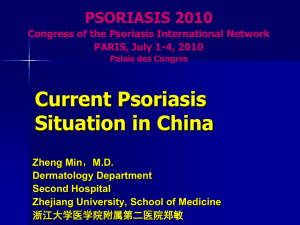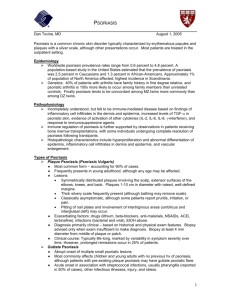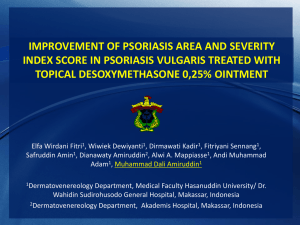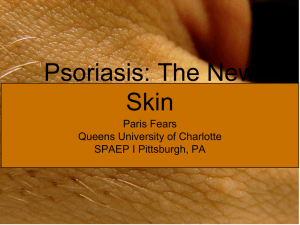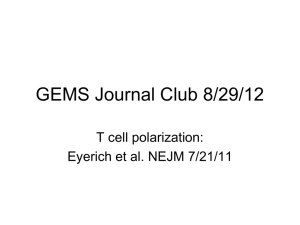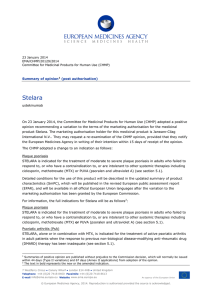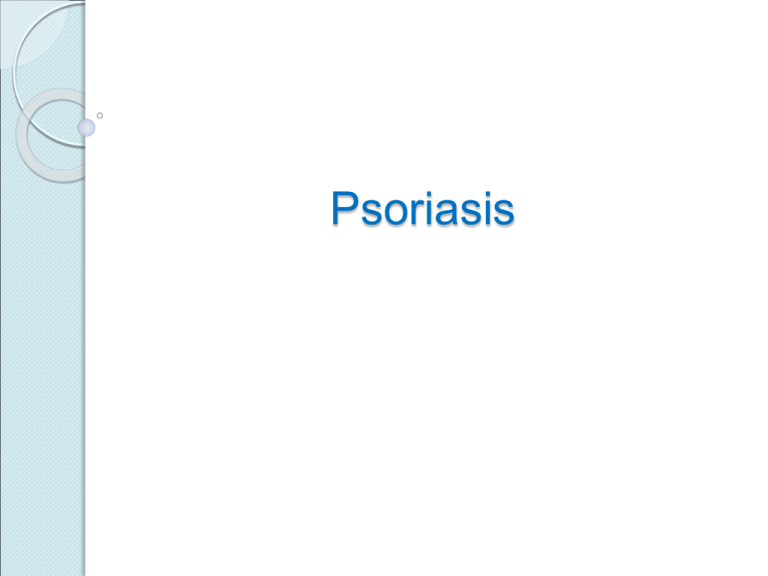
Psoriasis
Definition
Psoriasis is a common, chronic, disfiguring,
inflammatory and proliferative condition of the
skin; in which both genetic and environmental
influences play a critical role characterised by
red, scaly, sharply demarcated indurated
plaques of various sizes, particularly over
extensor surfaces and scalp.
Aetiopathogenesis
Genetic predisposition:
HLA-B13, B17, and Cw6
Epidermal hyperproliferation
Antigen driven activation of autoreactive T-cells
Angiogenesis
Multifactorial inheritance
Overexpression of Th1 cytokines such as IL 2,
IL 6, IL 8, IL 12, INF - γ, TNF α
Trigger factors
Trauma (Koebner phenomenon): Mechanical,
chemical, radiation trauma.
Infections: Streptococcus, HIV
Stress
Alcohol and smoking
Metabolic factors: pregnancy, hypocalcemia
Sunlight: usually beneficial but in some may
cause exacerbation
Trigger factors
Drugs:
Beta-blockers
NSAIDS
ACE inhibitors
Lithium
Antimalarials
Terbinafine
Calcium channel blockers
Captopril
Withdrawal of corticosteroids
Patient Profile
Sex: Adults (M=F) but in adolescents (F>M)
Age: 2 peak age ranges
1st peak : 16-22 years
2nd peak: 57-60 years
Earlier age of onset: Female sex
Positive family history
3-fold higher risk in siblings of patients with
onset before 15 years of age
History
Patients give H/O
Prominent itchy, red areas with increased skin
scaling and peeling.
New lesions appearing at sites of injury/trauma to
the skin (Koebner phenomenon)
Actual clearance of lesions following trauma to
the skin (Reverse Koebner phenomenon)
Exacerbation in winter, improvement in summer
Significant joint pain, stiffness, deformity in 1020%
Morphology
Classical Lesion: Erythematous, round to oval
well defined scaly plaques with sharply
demarcated borders
Scales: Psoriatic plaques typically have a dry,
thin, silvery-white or micaceous scale.
Sites: Elbows, knees, extensors of extremities,
scalp & sacral region in a symmetric pattern.
Palms/ soles involved commonly
Morphology
Auspitz sign:
Removing the scale reveals a smooth, red, glossy
membrane with tiny punctate bleeding points
Grattage test:
On grattage, characteristic coherence of scales
seen as if one scratches a wax candle(‘signe de
la tache de bougie)
Morphology
Koebner’s phenomenon
Linear distribution of the plaques seen along
scratch marks or at sites of trauma
Woronoff‘s ring
Psoriatic plaques occasionally appear to be
immediately encircled by a paler peripheral
zone.
Morphological Types
Chronic plaque psoriasis: plaques with less
scaling
Follicular psoriasis: follicular papules.
Linear psoriasis: linear arrangement of plaques
Annular/ figurate psoriasis: ring shaped or other
patterns.
Rupoid, elephantine and ostraceous psoriasis
Morphological Types
Guttate psoriasis: Common in children , good
prognosis
Pustular psoriasis: Crops of pustules based on
erythema
◦ Localised / generalised
◦ Impetigo herpetiformis
Erythrodermic psoriasis: 16-24% of all cases of
exfoliative dermatitis
Distributional Variation
Scalp psoriasis
Palmoplantar psoriasis
Nail psoriasis: pitting, onycholysis, subungual
hyperkeratosis, or the oil-drop sign. (25-50%)
Mucosal psoriasis
Inverse psoriasis:
◦ spares the typical extensor surfaces
◦ affects intertriginous (i.e, axillae, inguinal folds,
inframammary creases) areas with minimal
scaling.
Psoriasis in children and in HIV
Psoriasis in children:
Plaques not as thick as in adults, less scaly
Diaper area in infants, flexural areas in children
Face involvement more common than in adults
Psoriasis in HIV:
Acute onset
Severe flares
Poor prognosis
Psoriatic arthritis
Seen in 5-10% of psoriatic patients
Types:
1. Classic (16%)-DIP joint involvement
2. Oligoarticular (70%)
3. Rheumatoid type(15%)
4. Psoriatic spondylitis (5%)
5. Arthtritis mutilans (5%)
Contd…
Psoriatic arthritis
Associations:
Tenosynovitis
Enthesitis
Osteolysis
New bone formation
Joint fibrosis & ankylosis
Complicated psoriasis
Erythrodermic psoriasis
Generalised pustular psoriasis
Psoriatic arthritis
Histopathology
Skin biopsy findings:
Parakeratosis
Microabscesses of Munro in the horny layer
Absence of granular layer
Regular elongation of rete ridges (camel-foot
shaped)
Suprapapillary thinning of st.malpighii
Spongiform pustules of Kogoj
Dilated and tortuous capillaries in dermal
papillae
Superficial perivascular inflammatory infiltrate
Differential diagnosis
Nummular eczema
Tinea corporis
Lichen planus
Secondary syphilis
Pityriasis rosea
Drug eruption
Candidiasis
Tinea unguium
Seborrheic dermatitis
Treatment
General measures:
Counselling regarding the natural course of
the disease
Weigh reduction in obese patients.
Avoidance of trauma or irritating agents.
Reduce intake of alcoholic beverages.
Reduce emotional stress
Sunlight and sea bathing improve psoriasis
except in photosensitive
Topical therapy
Emollients: white soft paraffin & liquid paraffin
Corticosteroids: Potent steroids like fluocinolone
acetonide, betamethasone dipropionate or
clobetasol propionate
5-10% Coal tar: for stable but resistant plaques
0.1-1% dithranol: for few stable, thick, resistant
plaques
Contd…
Topical therapy
Keratolytics & humectants: as adjuvants eg.
Salicylic acid 3-10%, urea 10-20%
Calcipotriene
Tazarotene
Macrolactams (calcineurin inhibitors):
Tacrolimus & Pimecrolimus.
Response to topical therapy
Effects of topical therapy evident in 2-3 weeks
Clearing of scale is usually observed first,
followed by flattening of the treated plaques
Resolution of erythema may take 6-8 weeks
Phototherapy
1. Extensive and widespread disease
2. Resistance to topical therapy
PUVA photochemotherapy (PUVA)
Combined use of a photosensitizing drug
methoxsalen (8-methoxypsoralens) with UVA
irradiation (320-400 nm)
Mechanism of action:
1. Interferes with DNA synthesis →
decrease cellular proliferation
2. Induces apoptosis of cutaneous lymphocytes
(localized immunosuppression).
Method of administering PUVA
0.6mg/kg of 8-MOP(methoxypsoralen) given 2
hrs before irradiation
Initial dose of UVA is 2-5 J/cm2 with exposure
time of 5 mins
PUVA administered 2-3 times per week in an
outpatient setting.
Every week UVA dose increased by 20% and
exposure time by 5 mins
Maintenance treatments every 2-4 weeks until
remission
Relief with 20-30 treatments
Side Effects
Nausea, pruritus, burning sensation.
Long-term complications
◦ photo damage to the skin
◦ skin cancer
UVB phototherapy
Irradiation with light of wavelength 290-320 nm
Effective for moderate to severe psoriasis
Usually combined with one or more topical
treatments like tar or anthralin
Narrow-band UVB phototherapy
Use of a fluorescent bulb with a narrow
emission spectrum that peaks at 311 nm (UVB
spectrum, 290-320 nm).
More effective than broadband UVB for the
treatment of plaque-type psoriasis
Systemic Agents
Indications:
Resistant to both topical treatment and
phototherapy
Active psoriatic arthritis.
Physically, psychologically, socially or
economically disabling disease
Steroids: only used in life threatening situations
like erythrodermic & pustular psoriasis.
Cyclosporin: Immune modulator
◦ Used in erythrodermic & resistant psoriasis
◦ Limitations: expensive & nephrotoxic and
hypertensive
Systemic Agents
Methotrexate:
◦ Three doses of 2.5-5 mg orally 12 hrly or 7.5-15
mg single dose; administered every week.
◦ Contraindicated in hepatic & renal diseases.
Close monitoring of blood counts & hepatic
function essential.
Acitretin:
◦ For widespread psoriasis; combination with
PUVA reduces total cumulative dose of UV
irradiation
◦ Contraindicated in pregnancy & women of child
bearing age
Biological therapies
Selective, immunologically directed intervention at
key steps in the pathogenesis of the disease.
Mechanism of action:
Inhibits the initial cytokine release and
Langerhans cell migration
Targets activated T cells, prevents further T-cell
activation, and eliminates pathologic T cells;
Inhibits proinflammatory cytokines, such as TNF
Biological therapies
Indications:
Severe, recalcitrant cases
Psoriatic arthritis
Mode of administration:
Intravenous, Subcutaneous
Biological agents:
Efalizumab (Raptiva)
Etanercept (Enbrel )
Infliximab (Remicade)
Prognosis
Course of plaque psoriasis is unpredictable.
Characterised by remissions and relapses
Often intractable to treatment
Relapses in most patients
Improves in warm weather
Poor Prognostic factors:
Early onset, Family history, Stress, HIV infection
Thank you

